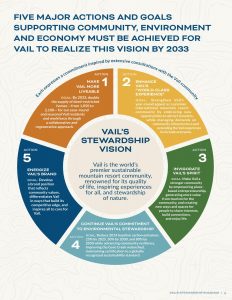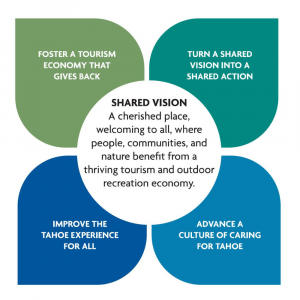The United States is a large and diverse country with many different types of tourism destinations, ranging from gateway communities to natural wonders and meccas for outdoor recreation, to both Atlantic and Pacific coastal communities, to iconic world class cities and cultural hubs. This means that there is no one-size-fits-all solution for destination stewardship and each destination needs to tailor its approach according to its specific context, needs, and goals. The US has a federal system of government, where power is divided between the national, state, regional, and local levels. This creates complexity and presents challenges for coordination and collaboration among different stakeholders and authorities involved in destination stewardship. For example, some destinations may face conflicting regulations or policies from different jurisdictions that affect their tourism development or management.
The housing crisis also looms large in the US (and Canada as well), due in part to a boom in migration from larger cities towards outdoor recreation communities, and has exacerbated the workforce shortage that began before the pandemic. Obtaining affordable, and available housing is an issue for all workers, not just hospitality staff looking for somewhere affordable to live near their place of work. Visitor management is also a key issue.
Overcrowding on public lands is a more recent phenomenon. In many instances, particularly more rural areas, parking restrictions and paid parking were not a common necessity, but now many regions are having to implement solutions to address crowding and congestion, such as timed ticketing systems, shuttle buses, digital tools to educate and identify overtouristed areas and educating visitors on underutilised or lesser known areas to visit. Transport also compounds issues. The train network in North America is not as developed as it is in Europe for example and distances between hotspots can be far, meaning many visitors drive, increasing congestion, parking needs, and emissions.
In regards to resident sentiment and community engagement, there have been instances of reducing satisfaction around tourism’s impacts on quality of life and increasing concern from destination managers about how to engage and improve local-visitor interactions. In most cases negative sentiment has been due to disrepectful attitudes and behaviours, increased instances of waste and litter in public spaces, and issues with access for locals – on roads, trails, and amenities like restaurants and beaches and natural areas during peak times. While engagement processes are increasingly being employed, reaching diverse populations is a continued challenge and requires creative and additional efforts to ensure engagement is truly representative of community voices including, for example, non-English speakers, Indigenous peoples, and young people.
In 2022 and 2023 we supported a number of tourism destinations in the US, including Lake Tahoe and the mountain town of Vail, and the coastal community of Oceanside to identify how best tourism can best work for residents and visitors.
A focus on two outdoor recreation destinations — Tahoe and Vail
Tourism and outdoor recreation play major roles in both the Lake Tahoe region and the Town of Vail, but both destinations sought to create a vision and framework for better destination stewardship that supported communities, the environment, the visitors and tourism industry alike.
Background
Vail, a popular mountain resort town in Colorado has tourism at its heart – it was founded as a ski resort in 1962. For much of its history, its focus had been to meet the needs of visitors. And increasingly it was focused on environmental preservation – in 2018 it went through the process of destination audit and certification through the Mountain IDEAL program, accredited by the Global Sustainable Tourism Council. Over time it was becoming increasingly clear that the needs of the community needed more attention. Vail attracts 2.5 million visitors a year yet less than 5,000 people live in the 10-mile stretch of town and 61% of homes are now owned by seasonal residents. Even during the global COVID crisis Vail continued to see record-breaking numbers of visitors. This increased footfall put pressure on natural resources, infrastructure, housing access and supply and social relations between guests and local people.
A similar issue was happening in the Lake Tahoe region. Tourism is the region’s lifeblood, with more than 15 million visits a year which generates more than $4.5 billion in direct spending. Yet large visitor numbers were causing multiple negative impacts such as an increase in plastic waste, traffic congestion, overcrowding, disrespectful behaviour and pollution of the iconic lake for which the region is named. Visitor numbers also continued to increase there during the pandemic. That along with an increase in migration from cities to less densely populated spaces such as Tahoe drove property prices way beyond the means of most local people.
Activities
We worked with MMGY NextFactor and Better Destinations to create one of the USA’s first destination stewardship plans, for the mountain resort of Vail. The plan was created through a 17-month community-driven process. More than 3,000 opinions were shared by locals and hundreds of regional stakeholders were included through interviews, town hall meetings, surveys and focus groups. Our role, with support from Green Destinations and other founders of the Future of Tourism Coalition, was to analyze the town’s sustainability practices, examine tourism’s impacts and how to optimize its value through our Optimal Value Framework (OVF), our strategic approach that can be used to help destination stakeholders work together to understand and optimize the value of tourism for their community, and to recommend future actions to advance stewardship.
In Tahoe we worked with the Center for Responsible Travel (CREST), Better Destinations, SMG Consulting and Civitas to support the Tahoe region to develop a shared vision around how tourism is managed and improve its impact on the environment, local communities, businesses and visitors.
Destination stewardship work in Tahoe built upon the new collaboration of stakeholders formed during the pandemic to address the issues the crisis brought. Representatives of 17 organizations from the Tahoe region, including five county governments, the City of South Lake Tahoe and the Town of Truckee, alongside environmental and community NGOs, the Forest Service and the regional planning agency, were involved in developing the destination stewardship plan along with participation of over 3,000 residents, visitors, and businesses through surveys, interviews, and workshops. The work highlighted the essential need for collaboration across sectors to address the multiple challenges in the destination. Our role was to support CREST with the management of the project and coordination of stakeholder engagement. We also conducted an analysis using our OVF to identify risks, opportunities and recommended actions that would be most likely to increase the benefits of tourism and minimize the cost or negative impacts, for incorporation into the overall strategy and action plan.
Outcomes
Both Vail and Tahoe released their first-ever destination stewardship plans in 2023. Vail hopes to be “the world’s premier sustainable mountain resort community, renowned for its quality of life, inspiring experiences for all, and stewardship of nature.” Tahoe’s vision is to be “a cherished place, welcoming to all, where people, communities, and nature benefit from a thriving tourism and outdoor recreating economy.”

Vail’s goals are to manage the growth of their tourism economy, protect their way of life and the natural environment that they all love, and maintain a world-class experience for their visitors and residents. The 10-year plan aims to strengthen the community, foster a more resilient visitor economy, and steward the natural environment. It marks the start of a new “community-positive” focus for Vail, recognising that tourism is the economic backbone of the town, but that tourism must also meet the needs of the community for the destination to thrive. Vail’s plan has 5 major actions, with 40 accompanying strategies, targets and indicators mapped out across the short-, medium- and long-term. Strategies include initiatives to encourage local entrepreneurship, broaden local access to Vail’s offerings and analyse carrying capacity to better cope with demand. It’s clear that housing is a main concern. Vail hopes to ‘make Vail more liveable’ by doubling the supply of deed-restricted homes by 2033. Collaboration is another major focus, with residents believing that greater cooperation among resorts and the town would help mitigate tourism pressures. Our sustainability work (OVF) for Vail highlighted nine high priority areas that need attention, mostly relating to the environment but also including limited resident access to the local tourism economy, Vail’s heavy dependence on tourism and workforce pressures.

Tahoe’s vision is built upon four ‘strategic pillars’, with each pillar encompassing a major goal along with objectives and priority action steps to achieve it. A top priority for all stakeholders is taking better care of the environment, while acknowledging the tourism economy must remain strong. Key to destination stewardship success is better management of resources through effective collaboration and collective action.
Our work for Tahoe analyzed current efforts to address key challenges across the region to identify recommended actions and monitoring indicators. Our OVF highlighted priority areas for action around social and environmental concerns as well as suggestions for tourism product and marketing and destination governance including funding, and provided a set of recommendations, which inform Tahoe’s destination stewardship action plan. Social priorities included how tourism impacts quality of life and access to recreation sites. The process also resulted in a set of boundary limits, early warning signals and monitoring indicators for Tahoe to use as an ongoing tool for future destination management. It should be noted that the challenge of adequate and affordable housing is just as much a concern for Tahoe as Vail, and separate housing planning and development initiatives are underway there and therefore were less of a focus of Tahoe’s DSP.Tahoe’s OVF
Next steps
Vail is working on an implementation plan for each of the plan’s five actions. Town departments have committed to resourcing the strategies that are prioritised for 2024 and building work into action plans. A public dashboard will be made available later in 2023 which will show strategies and actions. Tahoe has formalized their destination stewardship council and partners have committed funding for staff resources in order to continue the collaborative work between stakeholders, residents, and visitors and as a mechanism to action their destination stewardship plan.
Find out more
